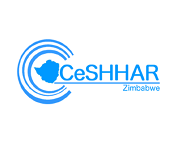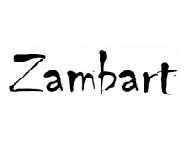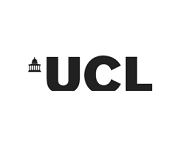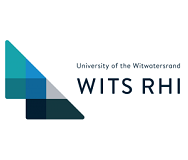HIV Self-Testing for Africa (STAR) Impact Evaluation in Zambia
By Lucheka Sigande, Nixon Handima and Dickson Tsamwa
The Zambia STAR Impact Evaluation (IE) Team shares their experiences during the endline survey of a pair-matched Cluster Randomised Trial (CRT) undertaken to estimate the impact of the distribution of oral HIV self-testing kits on people who have recently (within the previous 12 months) and have ever tested for HIV.
Overall, the endline survey went on as planned, with minimal interruptions by natural factors like rain, despite undertaking the exercise during the rainy season.
The IE Team comprised the two study managers, Nixon Handima and Dickson Tsamwa, data manager Lucheka Sigande, and locally recruited five Survey Enumerators (SE) per site. The exercise was conducted in a “roll out” fashion, beginning with the Lusaka sites, moving on to Choma, then Kapiri mposhi and finally Ndola.
Training, mapping and data collection
As part of preparation of the SEs, a five-day training session was organised to take them through various relevant topics like Good Clinical Practices and conducting interviews, i.e. collecting data electronically.
The Study and Data managers took the facilitator role, presenting the various topics and engaging SEs in discussions. Role-plays were also used to check on the understanding of the topics presented.

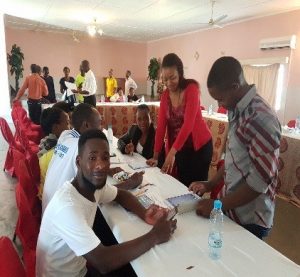
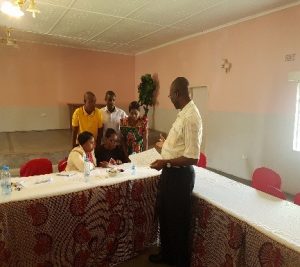
Survey Enumerators in session, looking through the end line survey processes – Choma
Google maps of the areas are generated by the spatial managers in the data department. The maps are sub-divided into Standard Enumeration Areas (SEAs) for the rural sites and Blocks for the urban sites. The SEAs and blocks are apportioned random numbers.
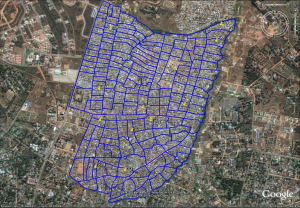
A sample of a map used during the survey
Prior to data collection, the data collection team, led by the CRT Manager, go through the map area boundaries on the ground, taking note of special landmarks, which SEs look out for during the data collection process, to ensure that they stay within the randomised SEA or block. The process may take a day or two, depending on a number of factors, especially in the rural sites where landmarks are few and the maps are usually taken at a high altitude, thereby not giving a vivid picture of structures on the ground. However, the use of locals as SEs proved handy in this case as they could easily locate major structures in the area. Finding our way through the process was not that much of a problem, especially for the endline survey since the baseline map provided some experience, which was utilised.
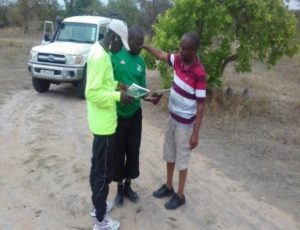
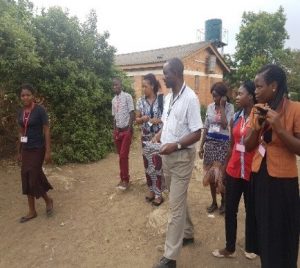
Figure 1a: Nixon, Benson Hayongo and James Phiri outlining SEA#1 in Mbabala – Choma
Figure1b: Dickson, Lucheka with some SEs walking through block 2 of Makeni – Lusaka
Data were collected electronically. The data collection process took about seven days in each site.
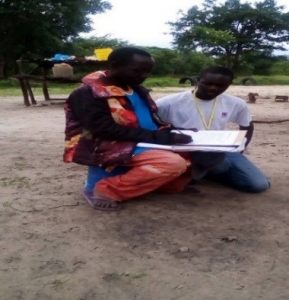

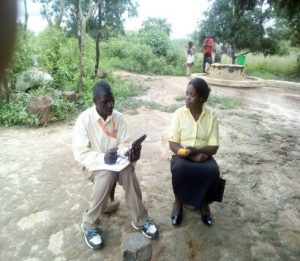
Figure 2a: A SE looks on as the participant signs the consent forms – Kapiri mponshi
Figure 2b: A SE helps an illiterate participant thumb print consent forms during the consenting process – Choma
Figure 2c: A SE administering the questionnaire electronically – Kapiri mponshi
A look at memorable field experiences
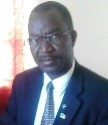
Study Manager, Dickson
Meeting the village headman of Chibuno, in Sikalongo, Choma, during the endline survey was a memorable experience for me because initially when we visited his residence, the headman did not outrightly express willingness to participate; he even started washing his cap saying he was about to go for a funeral of a relative who had passed on in the neighbouring village. Interestingly, the SE happened to have been a distant in-law to the same headman (he is married to the first cousin of the SE); who apparently, expressed ignorance of the funeral. To that effect, the headman slowed down on his alleged preparations to depart for the funeral and gave ear to our visit. After some introductory discussion, he became more than willing to take part. As a by the way discussion, while waiting on the SE to prepare herself; I engaged him to find out the origins of the name of the village “Chibuno” [literally translated to mean “waist”]. He did not have a clear answer to my question. Further asked how long he had been on the throne as village headman, the man could not tell, as he noted that he never entered school, as they used to run away with his friends, when it was time to go to school. However, he was a proud headman, boasting of being in charge of a big village; gave the boundary of his village and talked of how many people were under his charge, despite not being able to tell the number.
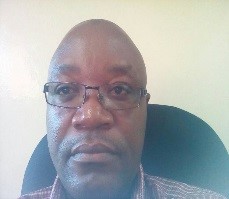
Study Manager, Nixon
During STAR’s endline survey, my most memorable time was in Choma’s Mapanza control site, where one SE was suspected to have been proposing love to the wife of the head of household (HOH). This was because during information giving, the survey enumerator did not mention to the young couple about the basic and extended individual questionnaire. It so happened that during the administration of the questionnaire, the HOH was selected to answer the basic questionnaire and the wife was selected to answer the extended questionnaire. The SE started with the HOH, whose questionnaire lasted about 25 minutes; after which he excused himself to escort a friend to a nearby village. The SE continued with the wife. The process took a bit more time as the respondent was very slow in responding to the questions. In the process, it started raining and the SE was invited in a small one roomed house to continue with his work. Whilst administering the questionnaire, the husband came back from escorting the colleague. He found the SE in the house still asking questions to his wife, he become suspicious and started questioning the SE as to why he took so long asking the wife, when with him it only took a few minutes. This really angered the man.
Considering the situation, the SE called on me as the field supervisor to help resolve the situation. As the field supervisor, I explained to the participant the whole process of how a participant is selected to respond to either the basic or extended questionnaire. The HOH was very understanding and happy with the explanation given to him. He also echoed that had the SE explained to them about the arrangement of the questions nothing would have happened. I then emphasised to the SE to explain the information to the participants in full to avoid such situation in future.
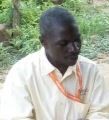
Survey Enumerator, Godfrey Miti – Kapiri mponshi
A couple in Kapiri Mponshi were both selected to answer the extended questionnaire. I reminded the couple that some questions were sensitive and needed privacy, but the couple told me that it was fine to administer the questionnaire as they were one. I started with the husband as he was going for work. On extra marital questions the husband responded that he had a girlfriend and that he had sex with her several times emphasising that even the wife knew about the affair. When I was done with the husband, he excused himself and left for work. I then administered the questionnaire to the wife and when I was done, I thanked the participant and left. As I was heading to the next household, surprisingly, I found the same husband who claimed was going for work standing by the roadside waiting for me. When I reached where the man was standing, he stopped me and started asking me what the wife’s response on the questions on extra marital status were. He wanted to know whether the wife also had a relationship outside their marriage.

Surevey Enumerator, Chipo Binde – Lusaka
I recall of a widow who was staying with her children. Her fifth born was HIV positive and the mother did not know. She decided that I interview her in the mother’s presence. When we got to the HIV question about one’s status, she declined to answer. I then asked her another HIV question and then she said: “I am HIV positive. I didn’t want anyone to know and that is why I am not taking ARVs hence my being sick at the moment. I don’t want my friends and family members to know my positive status because I am afraid of stigma.”
I also interviewed a cohabiting couple. The man said he was HIV positive and said he had a lot of girlfriends. The partner did not know all this. When I was done with the interviews, the woman wanted to leave the “boyfriend” because of his HIV status. After counselling them, they decided to go for VCT together.

Survey Enumerator, Lydia Muleya – Choma
Lydia narrates of two experiences she will live to remember, encountered during the end line survey, one in Sikalongo and the other in Batoka.
In Sikalongo, on two occasions within the same day, I met a 50 year old male and 30 year old female respondent who, after getting the whole information on the survey, both consented to taking part in the survey. They responded to the questionnaire without any difficulties. But upon completion of the questionnaire, they both expressed sadness and surprise at the fact that they were not being tested; they both stated that they were very sad that it was only information giving without testing.
I will live to remember these two respondents because the information on the survey was given in total, and they all agreed that they had understood it.
Another event from the end line survey was the reaction of one male parent, aged about 45 years in Batoka; who upon getting information on the survey, involving adolescents (16-17), cheerfully accepted the study and insisted to have his 13 and 15 year old children to be included in the study. It took me close to an hour to convince the man that the study was only considering those with 16-17 and 18 years and above. The man signed the consent form, but never stopped grumbling over the exclusion of the other young ones. In his grumbling he also complained on the concentration on information only, without doing the actual tests in the community; “eci tacili cibotu”, said the man in vernacular, meaning: “this is not good”.
Challenges
During the rainy season, data collection was interrupted at times due to the situation in the field like distance in between villages. Access to some places in rural areas was also challenging as the motor vehicle had to be left at some point, because small bridges made of logs were not in good state. This made the SEs to walk for an hour or more, to access the next village. Sometimes, one would walk such a distance, only to find one village with all villagers refusing to participate.
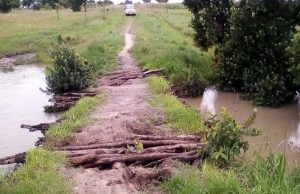
A bridge in SEA #2, Kapiri mposhi Nkole area. On this day, it had rained almost the whole night, the previous day.




